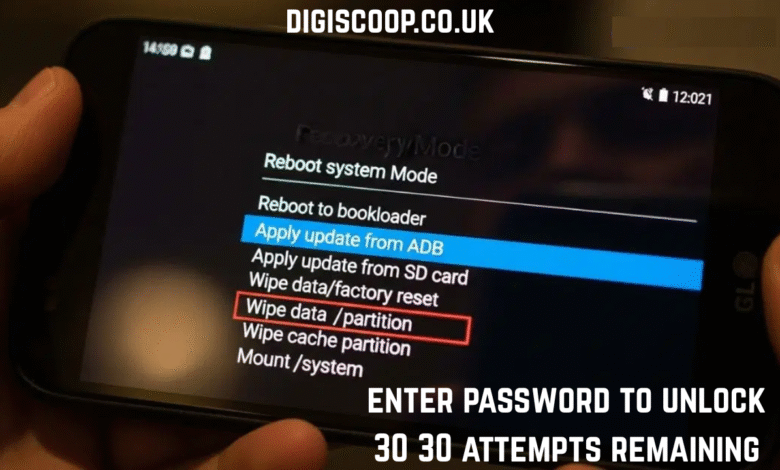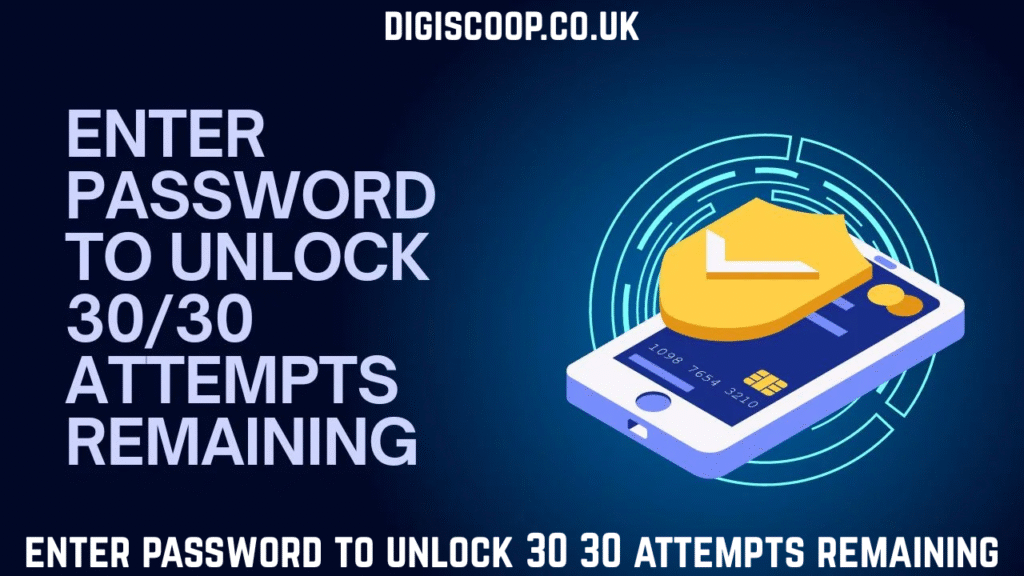Enter Password to Unlock 30 30 Attempts Remaining Complete Guide to Understanding Troubleshooting and Managing Security Access

Introduction to Enter Password to Unlock 30 30 Attempts Remaining
The notification “enter password to unlock 30 30 attempts remaining” is a critical message that appears when a user approaches the limit of allowed login attempts on a device, system, or online account. It serves as a warning that continued incorrect password entries could trigger a lockout or require additional security measures. This message is particularly common on smartphones, laptops, encrypted drives, and secure software platforms. While the number thirty might seem arbitrary, it is typically set to provide a balance between user convenience and system security. Users often overlook the significance of this message, thinking they can simply keep guessing, but in reality, this system-enforced limit is a safeguard against brute force attacks. Understanding this prompt is the first step toward ensuring your data remains safe while preventing unnecessary lockouts.
The second important aspect of the “enter password to unlock 30 30 attempts remaining” message is its role in guiding user behavior. By displaying the remaining attempts, the system provides a clear warning that every failed entry brings the user closer to restrictions that could include temporary locks, permanent account blocks, or even device resets. The message is not arbitrary; it is designed to make users pause, double-check their credentials, and prevent careless entry. For individuals managing multiple accounts or devices, ignoring this warning can lead to frustration and lost access, sometimes requiring technical support to regain control. Recognizing the importance of each attempt is crucial, as the system is effectively providing a final window of opportunity before stricter security measures are enforced.
Why the System Implements Enter Password to Unlock 30 30 Attempts Remaining

The reason behind the “enter password to unlock 30 30 attempts remaining” message is primarily security-focused. Limiting login attempts is a standard practice across operating systems, applications, and hardware devices. When a malicious actor tries to gain unauthorized access by guessing passwords repeatedly, this system-enforced limit drastically reduces the likelihood of success. The thirty attempts act as a buffer for legitimate users while maintaining strong protection against brute force attacks. Systems are programmed to lock accounts, temporarily freeze devices, or require additional authentication after reaching the maximum attempt threshold. In this way, the message is not just a warning; it is a proactive security measure that balances the risk of hacking with the needs of legitimate users to access their accounts without unnecessary disruption.
Another aspect of the “enter password to unlock 30 30 attempts remaining” implementation is its ability to provide user feedback. By notifying the user of remaining attempts, the system ensures transparency while reinforcing caution. This feedback encourages users to verify their passwords carefully before entering them, reducing the chances of accidental lockouts. Many individuals underestimate the value of such prompts, but they serve as a real-time safeguard, especially for devices storing sensitive personal, financial, or business data. The warning is intentionally repetitive to make users aware of their limited opportunities and to highlight the consequences of repeated mistakes. Systems that include this message demonstrate a proactive approach to cybersecurity, emphasizing prevention over recovery.
Common Situations Triggering Enter Password to Unlock 30 30 Attempts Remaining

Users encounter the “enter password to unlock 30 30 attempts remaining” message in a variety of situations. One of the most frequent scenarios is repeated failed login attempts due to forgotten passwords or typing errors. On devices like smartphones or laptops, entering an incorrect password several times in succession triggers this warning, making it clear that continued mistakes could lead to a lockout. Another common situation arises when users switch between multiple accounts and accidentally confuse passwords, especially when devices automatically fill credentials incorrectly. In corporate environments, shared devices or workstations also increase the likelihood of seeing this message, as multiple individuals may attempt to access the same account without proper knowledge of the correct password. Understanding the typical circumstances that lead to this warning helps users take preventive measures to avoid lockouts.
Additionally, security applications, encrypted software, and online banking platforms frequently use the “enter password to unlock 30 30 attempts remaining” prompt to prevent unauthorized access. Even if a user is confident about their password, repeated system errors, keyboard layout issues, or accidental caps lock activation can reduce the number of available attempts faster than anticipated. Devices and applications are designed to treat every failed entry equally, meaning users need to be highly attentive when entering credentials. Many support calls are generated because users ignore this message, assuming it is optional or negligible. By understanding the scenarios in which this warning appears, users can adopt proactive strategies such as password managers, secure backups, or writing down verified credentials temporarily to prevent exhausting attempts unintentionally.
Strategies to Manage Enter Password to Unlock 30 30 Attempts Remaining

One effective strategy for dealing with the “enter password to unlock 30 30 attempts remaining” message is to ensure that you have a reliable system for remembering or retrieving your passwords. Password managers, encrypted notes, or secure biometric authentication can minimize the risk of exhausting login attempts. Additionally, double-checking passwords for case sensitivity, keyboard layout issues, and numeric characters before entering them can save valuable attempts. Users should also avoid hasty entry, as rushing through credentials often leads to unnecessary errors. By treating the remaining attempts as a critical resource rather than unlimited tries, users increase the likelihood of successfully accessing their accounts without triggering device locks or system security measures.
Another essential approach is preparing for scenarios in which you may accidentally exceed your login attempts. Many systems allow recovery methods such as security questions, secondary email verification, or phone authentication after reaching the maximum attempts. For devices that do not support such recovery methods, backing up important data or creating secure recovery keys is vital. The “enter password to unlock 30 30 attempts remaining” message serves as a reminder that access is finite and mistakes can be costly. Users who adopt preventive measures often avoid frustrating lockouts and ensure that their devices or accounts remain secure while maintaining uninterrupted access to their important information.
Conclusion
In conclusion, the “enter password to unlock 30 30 attempts remaining” message is a vital security mechanism designed to protect users from unauthorized access while guiding them to handle passwords carefully. It appears in situations ranging from repeated typing errors to accidental account confusion and serves both as a warning and as a deterrent to malicious activity. By understanding the significance of each attempt, adopting strategies to remember passwords, and preparing for potential lockouts, users can maintain control over their accounts and devices. This message highlights the importance of balancing security with user accessibility, emphasizing caution, preparation, and awareness.
FAQs
Q1: What happens if I exceed 30 attempts?
Exceeding 30 attempts can result in a temporary lock, permanent lock, or a requirement for account recovery depending on the system. It is essential to follow recovery instructions carefully to regain access.
Q2: Can I reset my attempts?
Some systems allow resetting attempts through security questions, email verification, or device resets. Always ensure that your recovery options are active before reaching the limit.
Q3: How can I avoid triggering this message?
Using password managers, writing down verified credentials, and double-checking entries before submission are effective ways to avoid seeing the “enter password to unlock 30 30 attempts remaining” message.
Q4: Is this message an indication of hacking?
Not necessarily. While it could appear due to unauthorized attempts, most commonly it occurs because of typing errors or forgotten passwords. Monitoring account activity can provide additional security insights.
Q5: Why does the system display “30 30” specifically?
The repetition emphasizes urgency and provides a clear numeric warning, ensuring that users are aware of the remaining attempts and the consequences of continued incorrect entries.
Read More: New Software Name 8tshare6a A Complete Solution for Modern Digital Workflows




